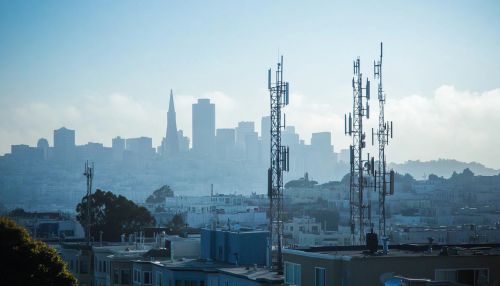Telecommunication in the 21st Century: Difference between revisions
(Created page with "== Introduction == Telecommunication in the 21st century has undergone a transformative evolution, driven by rapid technological advancements and the increasing demand for connectivity. This era has witnessed the convergence of traditional telecommunication systems with digital technologies, leading to the emergence of new communication paradigms. The integration of IP-based networks, the proliferation of mobile devices, and the advent of high-spee...") |
No edit summary |
||
| Line 9: | Line 9: | ||
The 21st century has seen a significant shift in mobile communication, marked by the transition from third-generation (3G) to fourth-generation (4G) and subsequently to fifth-generation (5G) networks. These advancements have enabled faster data transfer rates, reduced latency, and enhanced connectivity. The deployment of 5G technology, in particular, has facilitated the development of the [[Internet of Things|IoT]], enabling seamless communication between devices and fostering innovations in various sectors such as healthcare, transportation, and smart cities. | The 21st century has seen a significant shift in mobile communication, marked by the transition from third-generation (3G) to fourth-generation (4G) and subsequently to fifth-generation (5G) networks. These advancements have enabled faster data transfer rates, reduced latency, and enhanced connectivity. The deployment of 5G technology, in particular, has facilitated the development of the [[Internet of Things|IoT]], enabling seamless communication between devices and fostering innovations in various sectors such as healthcare, transportation, and smart cities. | ||
[[Image:Detail-99409.jpg|thumb|center|Modern city with visible telecommunication infrastructure, such as cell towers and antennas, against a skyline.|class=only_on_mobile]] | |||
[[Image:Detail-99410.jpg|thumb|center|Modern city with visible telecommunication infrastructure, such as cell towers and antennas, against a skyline.|class=only_on_desktop]] | |||
=== Broadband Internet === | === Broadband Internet === | ||
Latest revision as of 19:50, 29 October 2024
Introduction
Telecommunication in the 21st century has undergone a transformative evolution, driven by rapid technological advancements and the increasing demand for connectivity. This era has witnessed the convergence of traditional telecommunication systems with digital technologies, leading to the emergence of new communication paradigms. The integration of IP-based networks, the proliferation of mobile devices, and the advent of high-speed broadband have reshaped the landscape of global communication.
Technological Advancements
Mobile Communication
The 21st century has seen a significant shift in mobile communication, marked by the transition from third-generation (3G) to fourth-generation (4G) and subsequently to fifth-generation (5G) networks. These advancements have enabled faster data transfer rates, reduced latency, and enhanced connectivity. The deployment of 5G technology, in particular, has facilitated the development of the IoT, enabling seamless communication between devices and fostering innovations in various sectors such as healthcare, transportation, and smart cities.


Broadband Internet
Broadband internet has become a cornerstone of modern telecommunication, providing high-speed internet access to homes and businesses worldwide. The expansion of fiber-optic networks has played a crucial role in delivering gigabit-speed connectivity, supporting the growing demand for bandwidth-intensive applications such as streaming media and cloud computing. The deployment of submarine cables has further enhanced global connectivity, linking continents and facilitating international data exchange.
Satellite Communication
Satellite communication has experienced significant advancements, with the development of high-throughput satellites (HTS) and low Earth orbit (LEO) satellite constellations. These innovations have expanded the reach of telecommunication services to remote and underserved regions, providing reliable internet access and supporting disaster recovery efforts. Companies like SpaceX and OneWeb are at the forefront of deploying LEO satellite networks, aiming to create a global broadband infrastructure.
Impact on Society
Economic Implications
The evolution of telecommunication has had profound economic implications, driving growth in the digital economy and enabling new business models. The rise of e-commerce, digital marketing, and remote work has been facilitated by advancements in telecommunication infrastructure. Moreover, the telecommunication sector itself has become a significant contributor to global GDP, with investments in network expansion and technology development creating numerous job opportunities.
Social Connectivity
Telecommunication has transformed social connectivity, enabling people to communicate and collaborate across geographical boundaries. Social media platforms, instant messaging applications, and video conferencing tools have become integral to personal and professional interactions. The ability to connect in real-time has fostered global communities, promoting cultural exchange and understanding.
Challenges and Concerns
Despite the benefits, the rapid advancement of telecommunication technologies has raised several challenges and concerns. Issues such as cybersecurity, data privacy, and digital divide have become increasingly prominent. Ensuring secure communication channels and protecting user data from cyber threats are critical concerns for both service providers and regulators. Additionally, bridging the digital divide remains a priority, as disparities in access to telecommunication services persist, particularly in developing regions.
Future Trends
Artificial Intelligence and Automation
Artificial intelligence (AI) and automation are poised to play a pivotal role in the future of telecommunication. AI-driven network management and optimization can enhance the efficiency and reliability of communication systems. Automation technologies, such as machine learning algorithms, are being employed to predict network traffic patterns, optimize resource allocation, and improve customer service through chatbots and virtual assistants.
Quantum Communication
Quantum communication represents a frontier in telecommunication research, offering the potential for ultra-secure communication channels. Quantum key distribution (QKD) leverages the principles of quantum mechanics to enable secure encryption, making it virtually impossible for eavesdroppers to intercept messages. While still in the experimental stage, quantum communication holds promise for applications in national security and financial transactions.
Integration with Emerging Technologies
The integration of telecommunication with emerging technologies such as blockchain, augmented reality (AR), and virtual reality (VR) is expected to drive innovation and create new opportunities. Blockchain technology can enhance the security and transparency of telecommunication networks, while AR and VR applications rely on high-speed connectivity to deliver immersive experiences. These technologies are anticipated to revolutionize industries such as entertainment, education, and healthcare.
Conclusion
Telecommunication in the 21st century has been characterized by unprecedented advancements and transformative changes. The convergence of digital technologies with traditional communication systems has reshaped the way people connect, work, and interact. As the industry continues to evolve, addressing challenges such as cybersecurity, data privacy, and the digital divide will be crucial to ensuring equitable access to telecommunication services. The future of telecommunication promises exciting possibilities, driven by innovations in AI, quantum communication, and the integration of emerging technologies.
